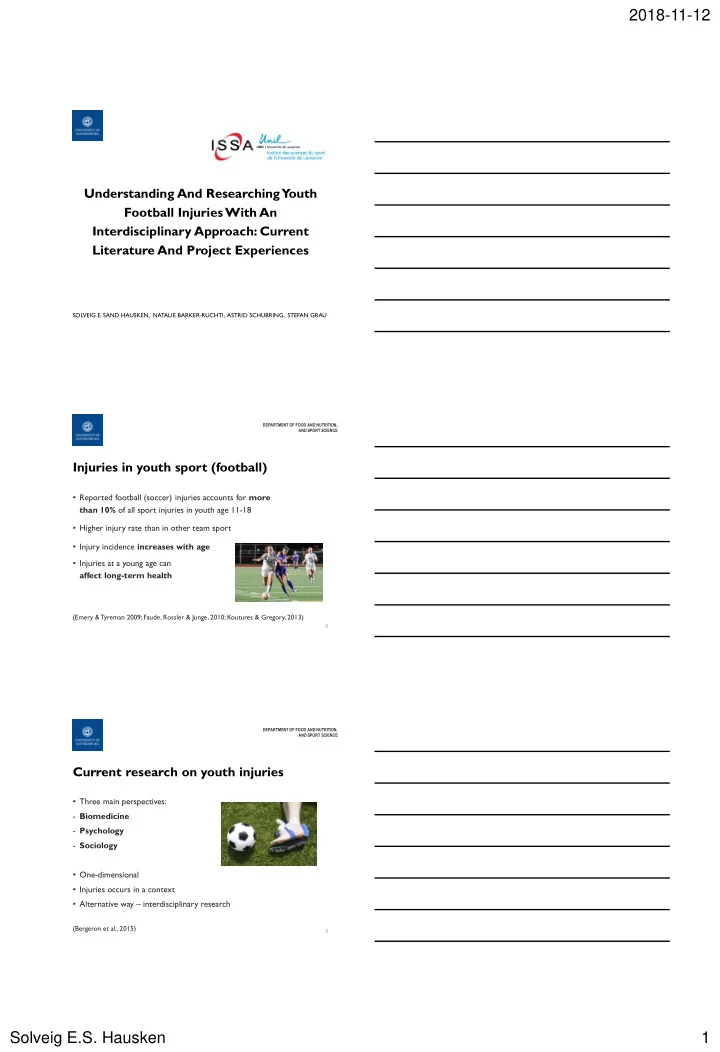

2018-11-12 Understanding And Researching Youth Football Injuries With An Interdisciplinary Approach: Current Literature And Project Experiences SOLVEIG E. SAND HAUSKEN, NATALIE BARKER-RUCHTI, ASTRID SCHUBRING, STEFAN GRAU DEPARTMENT OF FOOD AND NUTRITION, AND SPORT SCIENCE Injuries in youth sport (football) • Reported football (soccer) injuries accounts for more than 10% of all sport injuries in youth age 11-18 • Higher injury rate than in other team sport • Injury incidence increases with age • Injuries at a young age can affect long-term health (Emery & Tyreman 2009; Faude, Rossler & Junge, 2010; Koutures & Gregory, 2013) 2 DEPARTMENT OF FOOD AND NUTRITION, AND SPORT SCIENCE Current research on youth injuries • Three main perspectives: - Biomedicine - Psychology - Sociology • One-dimensional • Injuries occurs in a context • Alternative way – interdisciplinary research (Bergeron et al., 2015) 3 Solveig E.S. Hausken 1
2018-11-12 DEPARTMENT OF FOOD AND NUTRITION, AND SPORT SCIENCE What is interdisciplinary research? "Interdisciplinary research is a mode of research by teams or individuals that integrates information, data, techniques, tools, perspectives, concepts, and/or theories from two or more disciplines or bodies of specialized knowledge to advance fundamental understanding or to solve problems whose solutions are beyond the scope of a single discipline or area of research practice.“ *Committee on Facilitating Interdisciplinary Research, Committee on Science, Engineering, and Public Policy (2004). Facilitating interdisciplinary research . National Academies. Washington: National Academy Press, p. 2. 4 DEPARTMENT OF FOOD AND NUTRITION, AND SPORT SCIENCE Three perspectives to understand the literature • Themes 1. Body perspective – what questions are being asked? 2. Injury perspective – how are injuries defined? 3. Methodology – how are injuries registered and with what methods? 5 DEPARTMENT OF FOOD AND NUTRITION, AND SPORT SCIENCE Biomedical injury research Body perspective Injury perspective Methodology • Body as machine • Specific • Quantitative – physical testing • Modifiable • Related to individual physical • Injury registration • Normative factors – self reported, • Body in center medical experts • Needs expert treatment • Medical theory – descriptive (De Ridder et al., 2016; Friden & Heijne, 2017; Padua et al., 2015; Steffen et al., 2008; Thompson et al., 2017; Venturelli et al., 2011; von Rosen et al., 2017; Walden Hägglund & Ekstrand, 2001) 6 Solveig E.S. Hausken 2
2018-11-12 DEPARTMENT OF FOOD AND NUTRITION, AND SPORT SCIENCE Psychological injury research Body perspective Injury perspective Methodology • Specific • Body as separate • Quantitative – from the mind questionnaires • Individual • Modifiable but psychological • Injury registration together with the factors – self reported, mind medical experts • Needs expert • Physical body less treatment • Psychological in center together with the theories – mind descriptive (Brink et al., 2010; Ivarsson et al., 2014; Johnson & Ivarsson 2011; Steffen et al., 2009; Schwebel et al., 2007) 7 DEPARTMENT OF FOOD AND NUTRITION, AND SPORT SCIENCE Sociological injury research Body perspective Injury perspective Methodology • Body as a social • Not specific • Qualitative – product interviews, • Related to factors observations • Embodied outside of the body • No injury • Athlete in registration context • Injury part of a story • Social/sociological theories – prescriptive (Adams, Mason & Robifoux, 2015; Malcom 2006, Cavallerio et al., 2016; Roderick & Waddington 2000) 8 DEPARTMENT OF FOOD AND NUTRITION, AND SPORT SCIENCE So what now? How can we talk about a different understanding or an interdisciplinary understanding of (injury) research? How can we do research by keeping in mind what we leave out? 9 Solveig E.S. Hausken 3
2018-11-12 DEPARTMENT OF FOOD AND NUTRITION, AND SPORT SCIENCE “Injury free children and adolescents: T owards best practice in Swedish football (FIT project) • How do injuries develop over time Sub study 1 (questionnaire, and what are the individual 160 players) factors? Sub study 2 (biomedical • What combinations of physical testing, training protocol, Integrated dispositions lead to injuries? growth, 116 players) analysis: Portfolios, 6 Sub study 3 (observations, 6 players players) • How are contextual factors related to injuries/are contextual Sub study 4 (interview, 6 factors related to injuries? players) 10 DEPARTMENT OF FOOD AND NUTRITION, AND SPORT SCIENCE Project experiences, challenges and gains • Different expectations - Research quality - Sampling size - Recruitment • Finding a common language • Openness • Keep in mind what is being left out • Integrated analysis of data 11 DEPARTMENT OF FOOD AND NUTRITION, AND SPORT SCIENCE Thank you! Visit us at @fitprojektet 12 Solveig E.S. Hausken 4
Recommend
More recommend